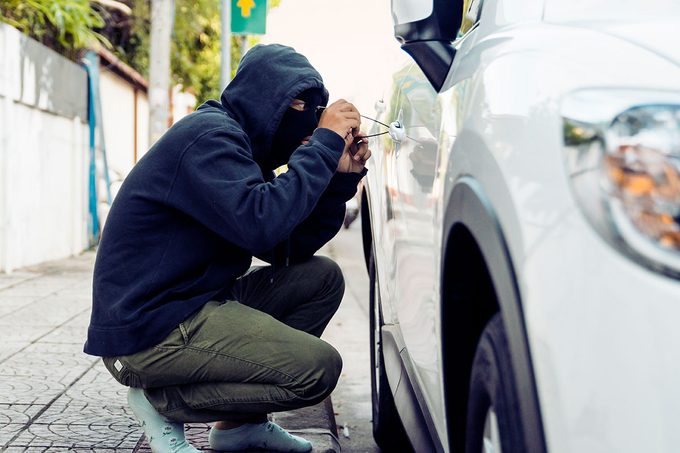You may think you're safe because your car has an alarm, but thieves know how to bypass the system ... and start your car remotely

Here’s the Sneaky New Trick Thieves Are Using to Break Into Locked Cars. Yours Could Be at Risk if You Don’t Do This

Rule No. 1 to avoid vehicle theft or break-ins is pretty straightforward—always lock your vehicle. Other common-sense strategies include basics like parking in well-lit areas and not leaving valuables in sight. But car thieves are clever, and it’s not that simple. “A constant challenge for crime fighters is that the methods criminals use to commit and conceal their acts against the public are always evolving,” explains Richard Spallinger, vehicle director at National Insurance Crime Bureau (NICB) Operations.
According to the NICB, annual car thefts dropped 17% in 2024, to 850,708. While this sounds good, it comes after a four-year surge, which peaked in 2023 with 1,020,729 vehicle thefts. “Vehicle crimes have surged across the nation since the start of the pandemic, especially in dense urban areas, and we’re still not yet at pre-pandemic figures,” Spallinger says.
You may remember your grandparents turning the key in the lock and then jiggling the handles to ensure the vehicle was secure. Depending on where you lived, you might even have grown up using a steering-wheel locking device like “The Club” for an extra level of security. Today, most cars come equipped with a factory-installed alarm system, but these safety features and tracking capabilities that are supposed to keep us safe also open up new ways for thieves to steal vehicles—even locked cars—without even breaking a window.
Keep reading to learn more about the new trick thieves are using to break into locked cars.
Get Reader’s Digest’s Read Up newsletter for more news, humor, travel, tech and fun facts all week long.
What’s the latest way thieves are breaking into locked cars?
The latest trick up car thieves’ sleeves is called a relay attack, in which thieves use devices called transmitters to remotely unlock vehicles. However, John Espenschied, an insurance expert reviewer at U.S. News & World Report and founder of Insurance Brokers Group, says this tactic has been around for a few years.
“Crooks hijack the wireless signal from your key fob,” Espenschied says. “They don’t need to steal your keys or smash a window; they just ‘copy and paste’ the signal from your fob to fool your car into thinking the key is right next to it.”
What is a transmitter?

“A transmitter is a device that can amplify your key fob signal and be used to enter a vehicle in the exact same way your actual fob does,” says Rocky Casullo of Casullo’s Automotive.
Espenschied explains that thieves use their own transmitters—one brand is known as a Flipper Zero, and it used to be sold on Amazon before the retailer banned it—to capture that signal and throw its voice like a ventriloquist. The transmitter near your car tricks the car into opening even when your actual key fob isn’t nearby.
How do transmitters work?
“Devices such as the Flipper Zero can detect and copy the frequencies our devices use every day, such as locks on cars, garage door openers, security fobs and even our credit card information,” explains Wesley Hartkemeyer, a Madison, WI, law enforcement officer. “Devices like the Flipper Zero allow criminals to sidestep safety protocols that used to make us feel secure.”
“It’s like a digital version of fishing your keys through the mail slot … without the fishing pole,” Espenschied says. “In other words, they’re unlocking—and sometimes even starting—your car while your keys are sitting harmlessly at home on the kitchen counter.”
Espenschied explains exactly how the dastardly plan unfolds:
- One thief stands near your house (yes, lurking on the sidewalk or driveway) holding a relay device that grabs your key fob’s signal right through walls or windows.
- That signal is sent to another thief standing by your car, who is holding a second device that relays the signal straight to your vehicle.
- Your car, thinking your key is within range, obediently unlocks the doors—or worse, lets the engine start and drive away.
Are transmitters readily available to purchase?
Unfortunately, devices such as the Flipper Zero are readily available for purchase. “The real-world purpose of these transmitters is for automotive key fob programming,” Casullo explains, adding that tools like the Flipper Zero can be retooled by car thieves to work as transmitters.
We looked at Flipper Zero’s website, and right on its homepage it says, “It loves hacking digital stuff, such as radio protocols, access control systems, hardware and more.” While transmitters like Flipper Zero are available for purchase, Amazon banned their sale because they’re frequently used as card-skimming devices. While it’s not illegal to own one, it is illegal to use one for stealing or other malicious purposes.
How can you protect your car from a thief with a transmitter?
Some things do make your car more likely to be stolen, so we need to control what we can. Casullo says that people in high-crime areas can wrap their key fob in aluminum foil, which will shorten the range and make it harder—if not impossible—for thieves to capture the signal. The downside is that the vehicle’s owner will also have to be closer to the car to unlock or start it, but that’s a small price to pay in exchange for an inexpensive, convenient solution that sure beats trying to recover a stolen vehicle.
Another option is RFID-blocking pouches (also called Faraday bags), which Espenschied says are “basically little sleeping bags for your key fob that block the signal from escaping.” If the thieves cannot detect or access the signal from your fob, they won’t be able to boost or relay it.
Espenschied suggests these simple ways to protect your car from thieves with transmitters:
- Don’t leave your keys near doors or windows—thieves love an easy target.
- Consider turning off keyless entry (some vehicles let you disable it in the settings).
- Use a steering wheel lock—yes, it looks old school, but it’s an extra layer of “not worth the hassle.”
- Update your car’s software to stay ahead of security vulnerabilities.
RELATED:
- 7 Sneaky Ways Burglars Can Break into Your House
- 35 Things You’re Doing That Make Your House a Target for Burglars
- 14 Things Home Security Experts Never Do in Their Own Homes
About the experts
|
Why trust us
At Reader’s Digest, we’re committed to producing high-quality content by writers with expertise and experience in their field in consultation with relevant, qualified experts. We rely on reputable primary sources, including government and professional organizations and academic institutions as well as our writers’ personal experiences where appropriate. We verify all facts and data, back them with credible sourcing and revisit them over time to ensure they remain accurate and up to date. Read more about our team, our contributors and our editorial policies.
Sources:
- ABC 6 Columbus, OH: “High-tech car thieves hit the streets as digital cloning turns vehicles into hot wheels”
- ABC 6 Philadelphia, PA: “Thieves cloning key fob signals to steal locked vehicles in Montgomery County, Pa.”
- NBC News 4 San Antonio, TX: “Car thieves using device to steal your key fob signal, then your car”
- National Insurance Crime Bureau (NICB): “Vehicle Thefts in United States Fell 17% in 2024”
- Richard Spallinger, vehicle director, NICB Operations
- John Espenschied, insurance expert reviewer at U.S. News & World Report and founder of Insurance Brokers Group
- Wesley Hartkemeyer, police officer for the city of Madison, WI, and co-founder of Ireport.
- Rocky Casullo, founder and president of Casullo’s Automotive



